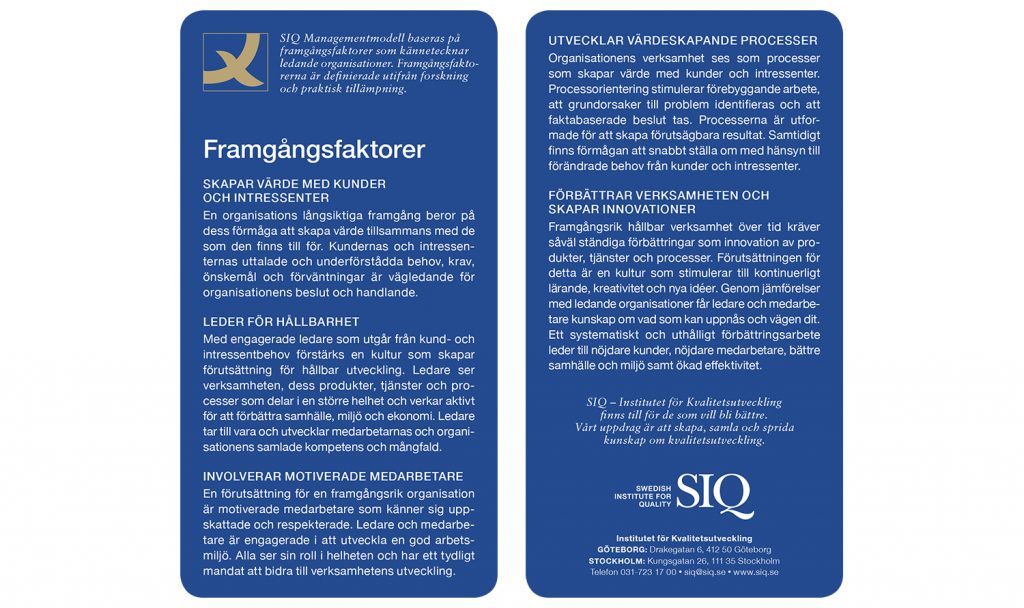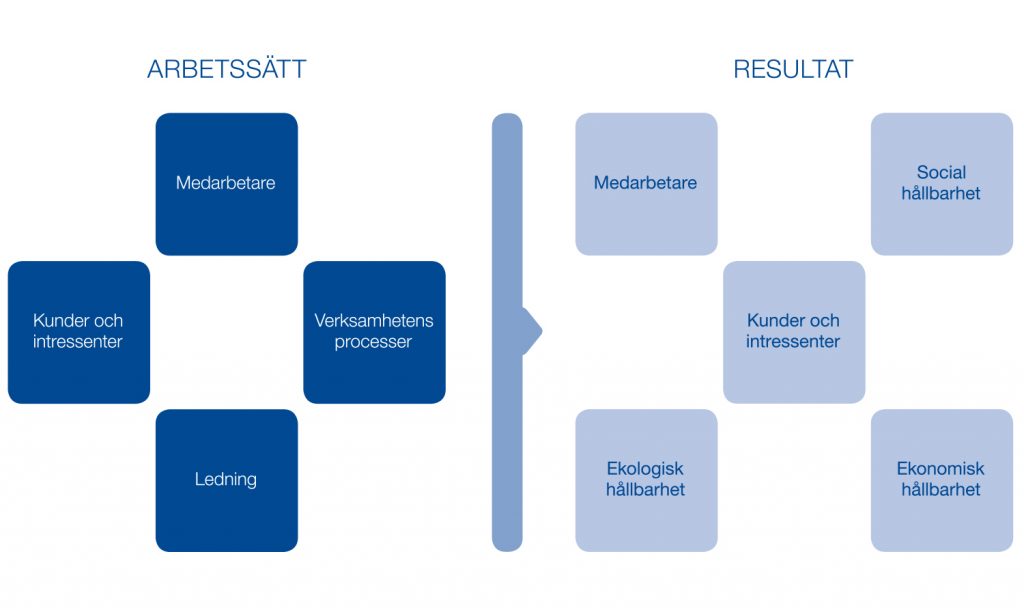SIQ management model
Developing adaptability at all times
SIQ Management model is a so-called 'excellence model'. Very simply, excellence models aim to support an organization to do the 'right things' in the 'right way' and achieve success. The 'right things' refer to products; goods and/or services that the organization's stakeholders, customers and users demand and value. The 'right way' means that the organization has and continuously develops appropriate ways of working and processes to deliver the 'right things'.
To be successful, there must always be a balance between what you deliver and offer as an organization and how you do it. There must be a balance between the internal and external effectiveness of an organization. Every organization lives in a changing world. What is the 'right thing' and the 'right way' today is not necessarily the right thing tomorrow. Therefore, the SIQ Management Model pushes and pushes to constantly develop the adaptability of the organization to always be relevant and thus achieve success.
The model is regularly updated
Updates on sustainability and strategic thinking
In early 2022, SIQ published several scientific papers on excellence models in the international journal Total Quality Management and Business Excellence. This new knowledge, together with feedback from users of the model, has contributed to a number of updates to the 2022 version of the SIQ Management Model - collectively developing the rationale for sustainable success in the fifth wave of quality - Quality 5.0.
Among other things, the model now asks for more clarity on the following:
- Prospective customers' expectations and wishes and how strategic work can clarify this.
- Proactivity and collaboration with partner businesses are also increasingly highlighted as important components in leading and managing towards sustainable success with economic, environmental and social sustainability.
- In this context, it is also important to have a common understanding of what process management means in practice with both trust-based and detail-based processes.
- Finally, this year's updated version also aims to develop a support for the development of the importance of employeeship for sustainable success - what does it mean for an organization to lead for employeeship?
The three pillars
Culture - The five success factors
The culture of SIQ Management Model is based on success factors that characterize leading organizations. The five factors guide decisions and actions for motivation and direction.

- Creating value with customers and stakeholders
The long-term success of an organization depends on its ability to create value with those it serves. The expressed and implied needs, requirements, wishes and expectations of customers and stakeholders guide the organization's decisions and actions. - Leading for sustainability
Committed leaders who focus on customer and stakeholder needs reinforce a culture that creates the conditions for sustainable development. Leaders see the business, its products, services and processes as parts of a larger whole and work actively to improve society, the environment and the economy. Leaders take advantage of and develop the collective skills and diversity of employees and the organization. - Involving motivated employees
A successful organization requires motivated employees who feel appreciated and respected. Managers and employees are committed to developing a good working environment. Everyone sees their role in the big picture and has a clear mandate to contribute to the development of the business. - Developing value-creating processes
The organization's activities are seen as processes that create value with customers and stakeholders. Process orientation stimulates preventive work, identifying root causes of problems and making fact-based decisions. The processes are designed to produce predictable results. At the same time, there is the ability to quickly adapt to the changing needs of customers and stakeholders. - Improving operations and creating innovations
Successful sustainability over time requires both continuous improvement and innovation in products, services and processes. This requires a culture that encourages continuous learning, creativity and new ideas. Benchmarking with leading organizations provides leaders and employees with knowledge about what can be achieved and how to get there. Systematic and sustained improvement work leads to more satisfied customers, more satisfied employees, a better society and environment and increased efficiency.
structures
The structure is a model for the questions we ask ourselves in order to see and organize.

Systematics
Systematics consists of a way of asking questions that lead to insight into how one's own activities work. It is only when we become aware of how we do things that we can improve what we do.
